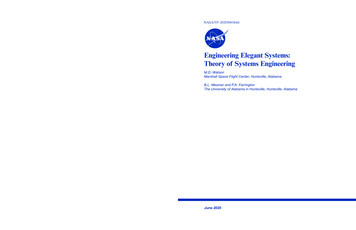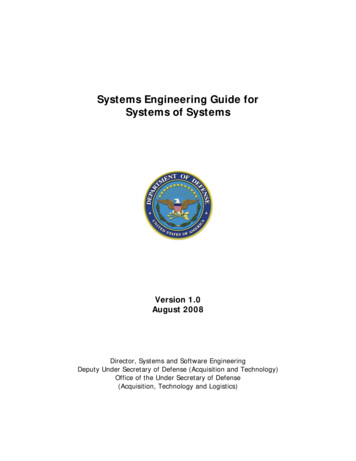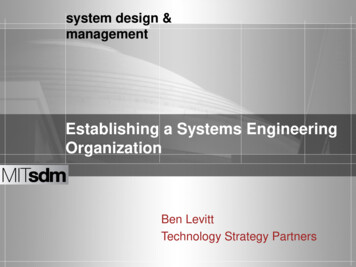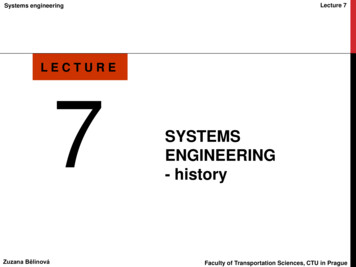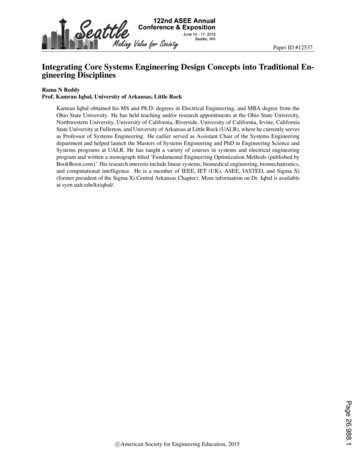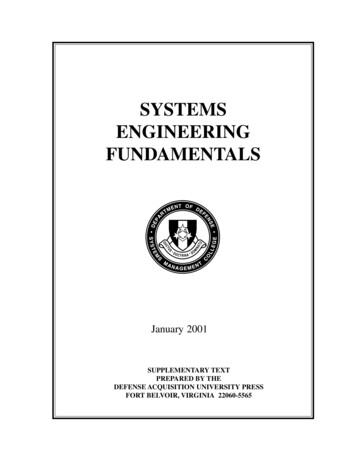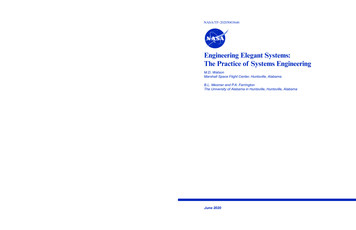
Transcription
National Aeronautics andSpace AdministrationIS02George C. Marshall Space Flight CenterHuntsville, Alabama 35812NASA/TP–20205003646Engineering Elegant Systems:The Practice of Systems EngineeringM.D. WatsonMarshall Space Flight Center, Huntsville, AlabamaB.L. Mesmer and P.A. FarringtonThe University of Alabama in Huntsville, Huntsville, AlabamaJune 2020
The NASA STI Program in ProfileSince its founding, NASA has been dedicated to theadvancement of aeronautics and space science. TheNASA Scientific and Technical Information (STI)Program Office plays a key part in helping NASAmaintain this important role.The NASA STI Program Office is operated byLangley Research Center, the lead center forNASA’s scientific and technical information. TheNASA STI Program Office provides access tothe NASA STI Database, the largest collection ofaeronautical and space science STI in the world.The Program Office is also NASA’s institutionalmechanism for disseminating the results of itsresearch and development activities. These resultsare published by NASA in the NASA STI ReportSeries, which includes the following report types: TECHNICAL PUBLICATION. Reports ofcompleted research or a major significantphase of research that present the results ofNASA programs and include extensive dataor theoretical analysis. Includes compilationsof significant scientific and technical dataand information deemed to be of continuingreference value. NASA’s counterpart of peerreviewed formal professional papers but has lessstringent limitations on manuscript length andextent of graphic presentations. TECHNICAL MEMORANDUM. Scientificand technical findings that are preliminary or ofspecialized interest, e.g., quick release reports,working papers, and bibliographies that containminimal annotation. Does not contain extensiveanalysis. CONTRACTOR REPORT. Scientific andtechnical findings by NASA-sponsoredcontractors and grantees. CONFERENCE PUBLICATION. Collectedpapers from scientific and technical conferences,symposia, seminars, or other meetings sponsoredor cosponsored by NASA. SPECIAL PUBLICATION. Scientific, technical,or historical information from NASA programs,projects, and mission, often concerned withsubjects having substantial public interest. TECHNICAL TRANSLATION.English-language translations of foreignscientific and technical material pertinent toNASA’s mission.Specialized services that complement the STIProgram Office’s diverse offerings include creatingcustom thesauri, building customized databases,organizing and publishing research results evenproviding videos.For more information about the NASA STI ProgramOffice, see the following: Access the NASA STI program home page at http://www.sti.nasa.gov E-mail your question via the Internet to help@sti.nasa.gov Phone the NASA STI Help Desk at757 –864–9658 Write to:NASA STI Information DeskMail Stop 148NASA Langley Research CenterHampton, VA 23681–2199, USA
NASA/TP–20205003646Engineering Elegant Systems:The Practice of Systems EngineeringM.D. WatsonMarshall Space Flight Center, Huntsville, AlabamaB.L. Mesmer and P.A. FarringtonThe University of Alabama in Huntsville, Huntsville, AlabamaNational Aeronautics andSpace AdministrationMarshall Space Flight Center Huntsville, Alabama 35812June 2020i
AcknowledgmentsThe progress made in defining elegant, product focused systems engineering is due to the work by the past and present members of the Systems Engineering Research Consortium. These researchers represent excellence in their areas of expertise and haveimpressed with their knowledge, intuition, and research. It is a pleasure working with and discussing with them the challengingquestions raised in the discipline of systems engineering. Phil Farrington, Paul Collopy, and Bryan Mesmer at The University ofAlabama in Huntsville have been outstanding leaders for the consortium. Present and past members are: Michael D. Griffin, Ph.D., former NASA Administrator Air Force Research Laboratory—Wright Patterson, Multidisciplinary Science and Technology Center: Jose A. Camberos,Ph.D., Kirk L. Yerkes, Ph.D. George Mason University: John S. Gero, Ph.D. George Washington University: Zoe Szajnfarber, Ph.D., Samantha Marquart Brainard, Ph.D. Iowa State University: Christina L. Bloebaum, Ph.D., Michael C. Dorneich, Ph.D. JBS Solutions: Sherrie Nash, Ph.D., Robert S. Ryan, Kenny Mitchell, Jeff Downs Massachusetts Institute of Technology: Maria C. Yang, Ph.D. Missouri University of Science & Technology: David Riggins, Ph.D. Multidisciplinary Software Systems Research Corporation (MSSRC): Larry Lambe NASA Langley Research Center: Peter A. Parker, Ph.D., Ken Toro, Anna R. McGowan, Ph.D., William Cirillo, Marie Ivanco,Kevin D. Earle NASA Marshall Space Flight Center: James G. Andrews, Jeri G. Eckley, Jennifer S. Stevens NASA Marshall Space Flight Center, Aetos Corporation: Michael L. Culver NASA Johnson Space Center: Gordon A. Vos, Ph.D. North Carolina State University: Jon Stallings, Ph.D. Alabama A&M University: Emeka Dunu, Ph.D. Oregon State University: Irem Tumer, Ph.D., Christopher Hoyle, Ph.D. SpaceWorks Enterprises, Inc.: John Olds, Ph.D. Stevens Institute of Technology: Khaldoun Khashanah Texas A&M University: Richard Malak, Ph.D., Robert Price Tri-Vector Corporation: Joey Shelton, Ph.D. The University of Alabama in Huntsville: Phillip A. Farrington, Ph.D., Dawn R. Utley, Ph.D., Laird Burns, Ph.D., Paul Collopy,Ph.D., Bryan Mesmer, Ph.D., P. J. Benfield, Ph.D., Wes Colley, Ph.D., Jeff Little, Ph.D., Dale Thomas, Ph.D., George J. Nelson,Ph.D., Casey Eaton University of Arkansas: David C. Jensen, Ph.D. University of Bergen: Erika Palmer University of Colorado – Colorado Springs: Stephen B. Johnson, Ph.D. Doty Consulting Services: John Doty, Ph.D. University of Maryland Eastern Shore: Andrew Barth University of Michigan: Panos Y. Papalambros, Ph.D., Melissa Greene, Ph.D., Arianne Collopy, Ph.D. The University of Texas at Arlington: Paul J. Componation, Ph.D., Susan Ferreira, Ph.D.Available from:NASA STI Information DeskMail Stop 148NASA Langley Research CenterHampton, VA 23681–2199, USA757–864–9658This report is also available in electronic form at http://www.sti.nasa.gov ii
PREFACEThe NASA Systems Engineering Research Consortium was founded to investigate the engineering and mathematical basis of systems engineering. The Consortium brought together sometremendous systems engineering researchers from across the country to contribute their investigativework to an integrated body of knowledge. I have had the great privilege of working with the researchers, discussing their research, and bringing together their tremendous intellectual understandings todefine the basis of systems engineering.In the summer of 2010, as NASA was transitioning from the cancellation of the Constellation program to the Exploration Systems Framework, NASA Marshall Space Flight Center (MSFC)Engineering Directorate Associate Director, Garry Lyles, asked my thoughts on systems engineering. He was looking for a way to advance the discipline. After discussing some of the characteristicsof a systems engineer stated by the Jet Propulsion Laboratory/Gentry Lee, Garry asked that I speakwith former NASA Administrator Mike Griffin, who was serving as The University of Alabama inHuntsville (UAH) Eminent Scholar and Professor of Mechanical and Aerospace Engineering. Theconversation with Mike revealed several common ideas on the challenges for systems engineeringand the path systems engineering needed to take to advance as a discipline. We agreed to establisha research effort to consider the advancement of systems engineering and provide an engineering andmathematical basis for the emerging discipline. The MSFC Space Launch System (SLS) programsupported the establishment of the Consortium, and a list of researchers who had a strong focus onthe engineering basis of systems engineering were asked to participate in early research efforts.Initial efforts in the consortium were an exploration of different engineering approaches forsystems engineering. Phillip Farrington became the principle investigator (PI) when Mike left UAHand became Chief Executive Officer of Schaffer Corporation. The four characteristics of an elegantsystem defined in Mike’s paper, ‘How do we fix System Engineering?’ guided the effort. These characteristics provided some focus, but a framework needed to bring all of the different engineeringaspects together and show their relationships to these characteristics of systems engineering. Wederived the framework, beginning in the spring of 2013, looking at the four different aspects of systems engineering identified in the early research: Mission context, system integrating physics, organizational structure and culture, and policy and law. These four areas provided two focuses to systemsengineering: system design and integration, and discipline integration.The systems engineering framework helped to focus the research and identify areas not studied by the Consortium. The Consortium adjusted the research portfolio at this point to address theseunderstudied areas. Mike and I had lunch or breakfast about every 3 months to discuss the progressand direction of the research. Mike challenged the Consortium to find a set of postulates that provided the basis for systems engineering. He used Maxwell Boltzmann’s work on the gas distributionlaws as an example. After looking at this, the Consortium drafted the first set of systems engineeringpostulates in the fall of 2013. These postulates have changed and improved over the last 5 years asthe Consortium membership reviewed them and contributed new understanding.iii
The development of the framework, postulates, and hypotheses integrated the research resultsprogressing at each of the Consortium member organizations. This progress led to several advancesin system design and integration, and discipline integration, forming the engineering and sociologicalbasis of systems engineering. System design and integration advances include the understanding ofthe application of systems engineering processes, identification of system integrating physics (systemexergy and optical transfer function), information theoretic statistics, state variable approaches (goalfunction tree and state analysis model), application of Multidiscipline Design Optimization (MDO),system value modeling, and various system modeling approaches in these areas. Section 3 of thisTechnical Publication describes the application of these system design and integration approaches.Discipline integration approaches include understanding organizational social behavior influenceson systems engineering, cognitive science, sociological principles, understanding the impact ofgovernment oversight, and various system modeling approaches in these areas. Section 4 describesthe application of these discipline integration approaches.As our research went on, Phillip Farrington retired from UAH and Bryan Mesmer becamethe Consortium PI. The research led to a deeper understanding of the postulates and their expansioninto a set of principles. These principles provided more indepth understanding of systems engineering, providing guidance on systems engineering that leads to the realization of elegant systems. Inaddition, a set of hypothesis emerged to address some limitations defined in some areas of systemcomplexity and system value modeling. Proofs are in development for these and one hypothesis hasbeen promoted to a principle once a proof (following information theoretic statistical approaches)was constructed.After an initial draft of the Systems Engineering Practitioner’s Guide in December 2014,the Consortium decided to split the document into two separate documents: “Engineering ElegantSystems: Theory of Systems Engineering,” and “Engineering Elegant Systems: The Practice ofSystems Engineering.” This allowed them to follow an outline organized solely by the systemsengineering framework for the presentation of theoretical materials and allowed them to base theframework in a lifecycle context for the presentation of practical approaches. Thus, this TechnicalPublication (TP) provides the view of how the different theoretical aspects are applied in practice.As the Theory of Systems Engineering progressed, the Practice of Systems Engineering hasfollowed. This TP captures the current understanding of how to apply the theory in the practice ofsystems engineering. The practical approaches take much longer to develop, so this represents aninitial view point of the practice stemming from the maturation of the theory. There will doubtlessbe an increase in the knowledge of how to put these approaches into practice as systems engineeringmatures as an engineering discipline.It has truly been a pleasure to work with all of the researchers participating in the Consortium.Their intellectual might and enthusiasm for the advancement of systems engineering is energizing.The contributions made by these researchers are available on the Consortium Web site (https://www.nasa.gov/consortium). There are over 100 papers on the site documenting the significant contributionsby the researchers. Their contributions have been the foundation to advancing the engineering basisof systems engineering!Michael D. Watson, Ph.D.NASA Marshall Space Flight Centeriv
TABLE OF CONTENTS1. ENGINEERING ELEGANT SYSTEMS .11.1 Definition of Systems Engineering .1.2 Overview .562. BASIS OF SYSTEMS ENGINEERING .72.1 Characteristics of an Elegant System.2.2 Systems Engineering Framework .2.3 Systems Engineering Principles .79113. ENGINEERING THE SYSTEM IN THE SYSTEMS ENGINEERINGFRAMEWORK .273.13.23.33.43.53.63.7Defining Mission Context (System Application)/Understanding the System .System Design and Analysis.System Analysis and Modeling .System Testing .System Manufacturing .System Operations .Engineering the System in System Lifecycle Summary .2843471041081081094. PRACTICE OF DISCIPLINE INTEGRATION .1114.14.24.34.4Organizational Structure and Information Flow .Policy and Law .Discipline Integration Modeling .Discipline Integration Summary .1111401491515. SYSTEMS ENGINEERING PROCESSES .1535.1 Systems Engineering Management Plan Technical Content . 1535.2 Systems Engineering Management Plan Technical Approach . 1546. CHARACTERISTICS OF A SYSTEMS ENGINEER .1557. SUMMARY .159v
TABLE OF CONTENTS (Continued)APPENDIX A—SYSTEMS ENGINEERING POSTULATES, STRATEGIES,AND HYPOTHESES .161A.1 Systems Engineering Postulates .A.2 Systems Engineering Strategies .A.3 Systems Engineering Hypotheses .161166173REFERENCES .177vi
LIST OF FIGURES1.System lifecycles .22.Systems engineering framework relationships .103.DC-3 aircraft .254.Saturn concept .335.The approach for determining derived technical requirements .346.HSI infuses human considerations into all phases of the engineeringlifecycle.39The cost to make design changes significantly increases laterin the engineering lifecycle .408.NASA HSI technical domains .419.Space Shuttle .4610.Elegant system design .4811.System model relationships .4912.System development model mapping to system operations functions .5313.System model mapping to operations engineering activities .5414.System robustness capability mapping .6215.Launch vehicle attributes related to a system value .6316.Screenshot of a slide from the 2017 satellite industry report .6617.Exergy destruction components for a C-17 airlifter .8118.Organizational culture influences . 11219.Discipline integration functions . 1137.vii
LIST OF FIGURES (Continued)20.President Kennedy addresses Congress and the Nation on May 25, 1961 . 14121.Governmental stakeholders influencing the development and operationsorganizations and working level . 14622.Example of a system dynamics model as an SFD . 15023.System behavior: Simulated (stock 1) versus actual (reference model behavior) . 15024.Characteristics of a systems engineer . 156viii
LIST OF TABLES1.Typical events and models for a launch vehicle .352.NASA HSI technical domains .423.Value of satellite benefits .674.Launch vehicle benefits for various mission types .675.Human exploration benefits to the U.S. economy .676. USD/kg values for launch vehicle propellants .687.Launch vehicle value .698.Launch vehicle mission reliability .699.Value of mission reliability for satellite mission types .6910.Lost value of unsuccessful satellite missions .7011.Value of 96% mission reliability .7012.Percentage of satellite market supported by different fairing sizes .7113.Value to satellite market of different fairing sizes .7114.Preference values for a heavy-lift launch vehicle with 10-m fairing .7215.Exergy relationships .7816.Post variables for exergy calculations .8417.Exergy balance equations for crew modules .8718.Exergy destruction calculations for the OGA .8919.Exergy destruction calculations for the CDRA .9020.Exergy destruction calculations for the MCA .92ix
LIST OF TABLES (Continued)21.Exergy destruction calculations for the TCCS .9322.Exergy destruction calculations for the THC .9523.Exergy destruction calculations for the WRM .9624.Exergy destruction calculations for the WM subsystem .9725.System statistical model comparison based on AIC or AICc deltas .9926.MDO model architecture types . 10127.Functional departmentation advantages and disadvantages . 13028.Divisional or team departmentation advantages and disadvantages . 13129.Matrix departmentation advantages and disadvantages . 132x
LIST OF ACRONYMS, ABBREVIATIONS, AND DESIGNATORSAAAavionics air assemblyABMagent-based modelAICAkaike information criteriaAICcAkaike information criteria correctedASOasymmetric subspace optimizationATCanalytical target cascadingBICBayesian information criteriaBLISSbilevel integrated system synthesisCACcontrol of airborne contaminantsCADcomputer-aided designCAMcomputer-aided manufacturingCCAAcommon cabin air assemblyCDRcritical design reviewCDRAcarbon dioxide removal assemblyCLDcasual loop diagramCMconfiguration managementConOpsconcept of operationsCoPcommunities of practiceCOPUOSCommittee on the Peaceful Uses of Outer SpaceCRchange requestxi
LIST OF ACRONYMS, ABBREVIATIONS, AND DESIGNATORS (Continued)CSSOconcurrent subspace optimizationDACdesign analysis cycleDESdiscrete event simulationDMdata managementDoDDepartment of DefenseDoEDepartment of EnergyDoTDepartment of TransportationDRMdesign reference missionECLSSEnvironmental Control and Life Support SystemECOenhanced collaborative optimizationEPAEnvironmental Protection AgencyEPDexact penalty decompositionEVMearned value managementFAAFederal Aviation AdministrationFCAfunctional configuration auditFEMfinite element modelFFRDCfederally funded research and development centerFMfunctional line managerFMEAfailure mode and effects analysisGDPgross domestic productGFTgoal function treexii
LIST OF ACRONYMS, ABBREVIATIONS, AND DESIGNATORS (Continued)GN&Cguidance, navigation, and controlHQHeadquartersHSIHuman System IntegrationHTPBhydroxyl-terminated polybutadieneIDFindividual discipline feasibleIMVintermodule ventilationIPDinexact penalty decompositionIPTintegrated product teamISSInternational Space StationJPLJet Propulsion LaboratoryLiOHlithium hydroxideM&FMmission and fault managementMATmaintenance access timeMAVERICMarshall Aerospace Vehicle Representation in CMBSEmodel-based systems engineeringMCAmajor constituents analyzerMDFmultidiscipline feasibleMDOmultidisciplinary design optimizationMDOCAmultidisciplinary design optimization coupling analysisMDOISmultidisciplinary design optimization of independent design subspacesMoEmeasures of elegancexiii
LIST OF ACRONYMS, ABBREVIATIONS, AND DESIGNATORS (Continued)MOOmulti-objective optimizationMTBFmean time between failuresMTTRmean time to repairNGOneeds, goals, and objectivesNRCNuclear Regulatory CommissionOGAoxygen generator assemblyOMBOffice of Management and BudgetOMLouter mold lineOSHAOccupational Healthy and Safety AdministrationPBANpolybutadiene acrylonitrilePBRPresident’s budget requestPBSproduct breakdown structurePCAphysical configuration auditPDRpreliminary design reviewPMproject managerPOSTProgram to Optimize Simulated TrajectoriesPRAprobabilistic risk assessmentQSDquasi-separable decompositionR&Dresearch and developmentRAMreliability, availability, and maintainabilityRP-1keroseneRTDresistance temperature detectorxiv
LIST OF ACRONYMS, ABBREVIATIONS, AND DESIGNATORS (Continued)S&MASafety and Mission AssuranceSAMstate analysis modelSANDsimultaneous analysis and designSCMsystem capability modelSDRsystem design reviewSEMPSystems Engineering Management PlanSETASystems Engineering and Technical AssistanceSFDstock and flow diagramSLSSpace Launch SystemSTSSpace Transportation SystemTCCStrace contaminant control subsystemTHCtemperature and humidity controlTICTakeuchi information criteriaTPTechnical PublicationUNUnited NationsV&Vverification and validationVRAvolatile removal assemblyWBSwork breakdown structureWMwaste managementWRMwater recovery moduleWSMwater separator modulexv
NOMENCLATUREAmodulecross-sectional area of vehicle or capsuleAOoperational availabilityCDdrag coefficientCTtotal costC! Ttotal annual cost of the launch vehicleCp,propellantheat capacity of propellantCtsystem costceiunit cost of external exergy outputdsdifferential entropydTdifferential temperaturedtdifferential timeEenergyFthrustthrustfphysical systemGuniversal gravitational constantggravitational acceleration, model of the systemHHVhigh heating valueHtotaltotal enthalpyhenthalpyh 0,propellantentropy of propellant in reference environment conditionsxvi
NOMENCLATURE (Continued)h1enthalpy at the beginning of the heating part of the cycleh2enthalpy at the beginning of the cooling part of the cyclehair,inspecific enthalpy of air enteringhair,outspecific enthalpy of air exitinghcabinenthalpy in the cabinhcoolant,inspecific enthalpy of coolant enteringhcoolant,outspecific enthalpy of coolant exitinghfinalspecific enthalpy leavinghH2,inspecific enthalpy of hydrogen enteringhH2,outhH2O,inhH2O,outspecific enthalpy of hydrogen leavingspecific enthalpy of liquid water enteringspecific enthalpy of liquid water leavinghinspecific enthalpy enteringhinitialinitial enthalpyhmoist air,inspecific enthalpy of moist air enteringhmoist air,outspecific enthalpy of moist air exitinghOspecific enthalpy of oxygen enteringhOspecific enthalpy of oxygen leavinghoutspecific enthalpy leavinghproppropulsion enthalpyhprop,enginepropulsion enthalpy in the enginehι,ienthalpy of injected propellant reactants2,in2,outxvii
NOMENCLATURE (Continued)hι ,wakespecific enthalpy of propellant reactants in the wakehι,urine,inspecific enthalpy of urine enteringhι,urine,outspecific enthalpy of urine leavingheightinheight enteringheightoutheight leavingIinformation discriminatorIcinformation capacityIc,finalfinal information capacityIc,initialinitial information capacityIspspecific impulseiinterest rateLRlaunch rateMmaintainability, massMEmass of the EarthMvehiclemass of vehicleMvehicle,finalfinal vehicle massMvehicle,initialinitial vehicle massm!mass flow ratem! airmass flow rate of airm! air,inmass flow rate of air enteringmCOmass of carbon dioxide vented to spacem! coolantmass flow rate of coolant flow through the precooler2xviii
NOMENCLATURE (Continued)m! depositedmass flow rate depositedmfluidfluid massm! H2,inmass flow rate of hydrogen enteringm! H2,outm! H2O,inm! H2O,outmass flow rate of hydrogen leavingmass flow rate of water enteringmass flow rate of water leavingm! imass flow rate of chemical species im! moist air,inmass flow rate of moist air enteringm! moist air,outmass flow rate of moist air leavingm! Omass flow rate of oxygen enteringm! Omass flow rate of oxygen leavingm! propellantmass flow rate of propellantm! urinemass flow rate of urinem! wakemass flow rate of air in the wakePpressure, principle revenueP0reference environment pressurePcabinpressure in the cabinPiinitial pressurePwakepressure in the wakeQ!heat transfer rate from the blowerQcrewamount of heat from the crewQ!heat transfer rate in the electrolyzer2,in2,outblowerelecxix
NOMENCLATURE (Continued)Q!heat transfer r
University of Maryland Eastern Shore: Andrew Barth University of Michigan: Panos Y. Papalambros, Ph.D., Melissa Greene, Ph.D., Arianne Collopy, Ph.D. . exergy and optical transfer function), information theoretic statistics, state variable approaches (goal . After an initial draft of the Systems Engineering Practitioner's Guide in .


